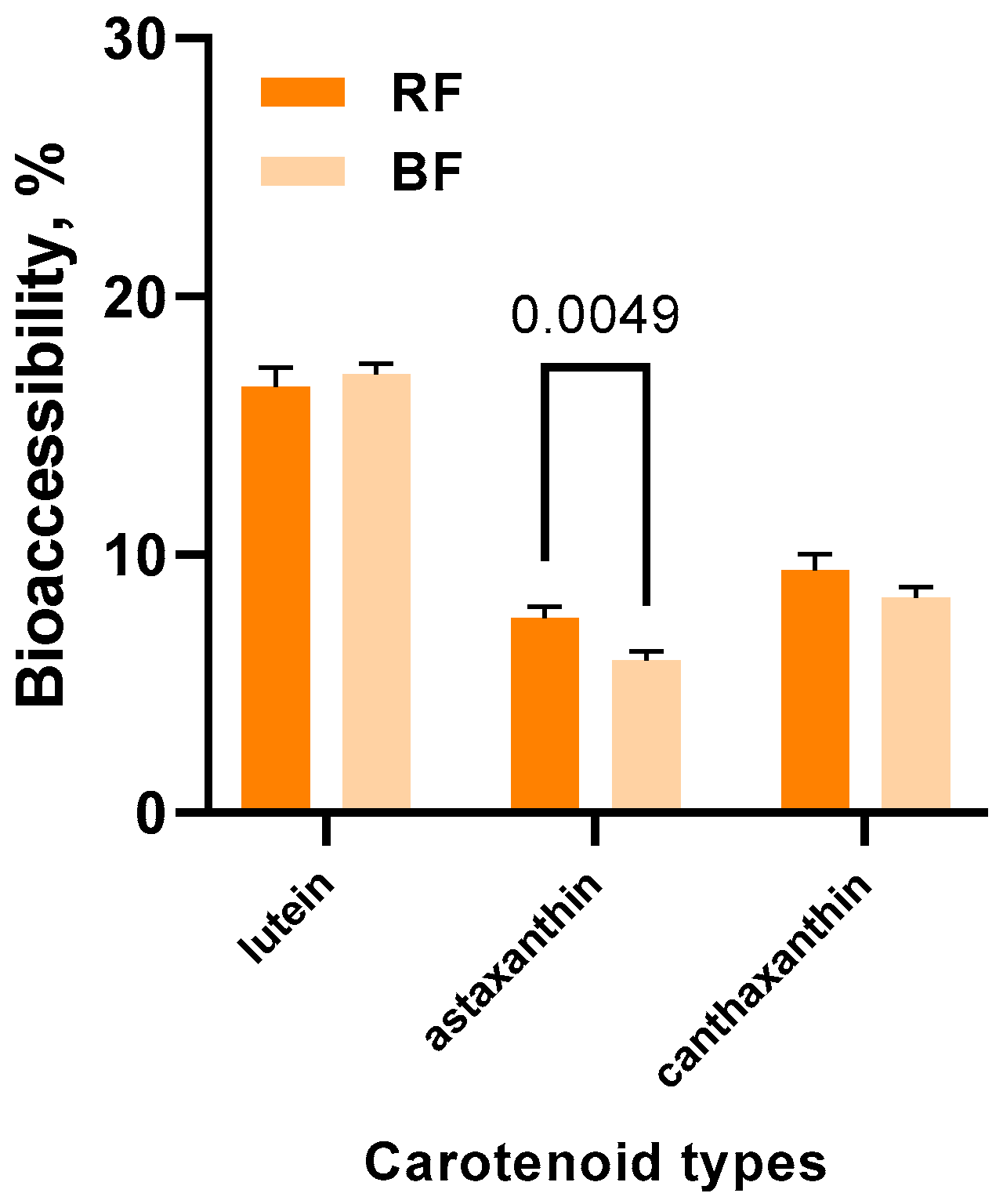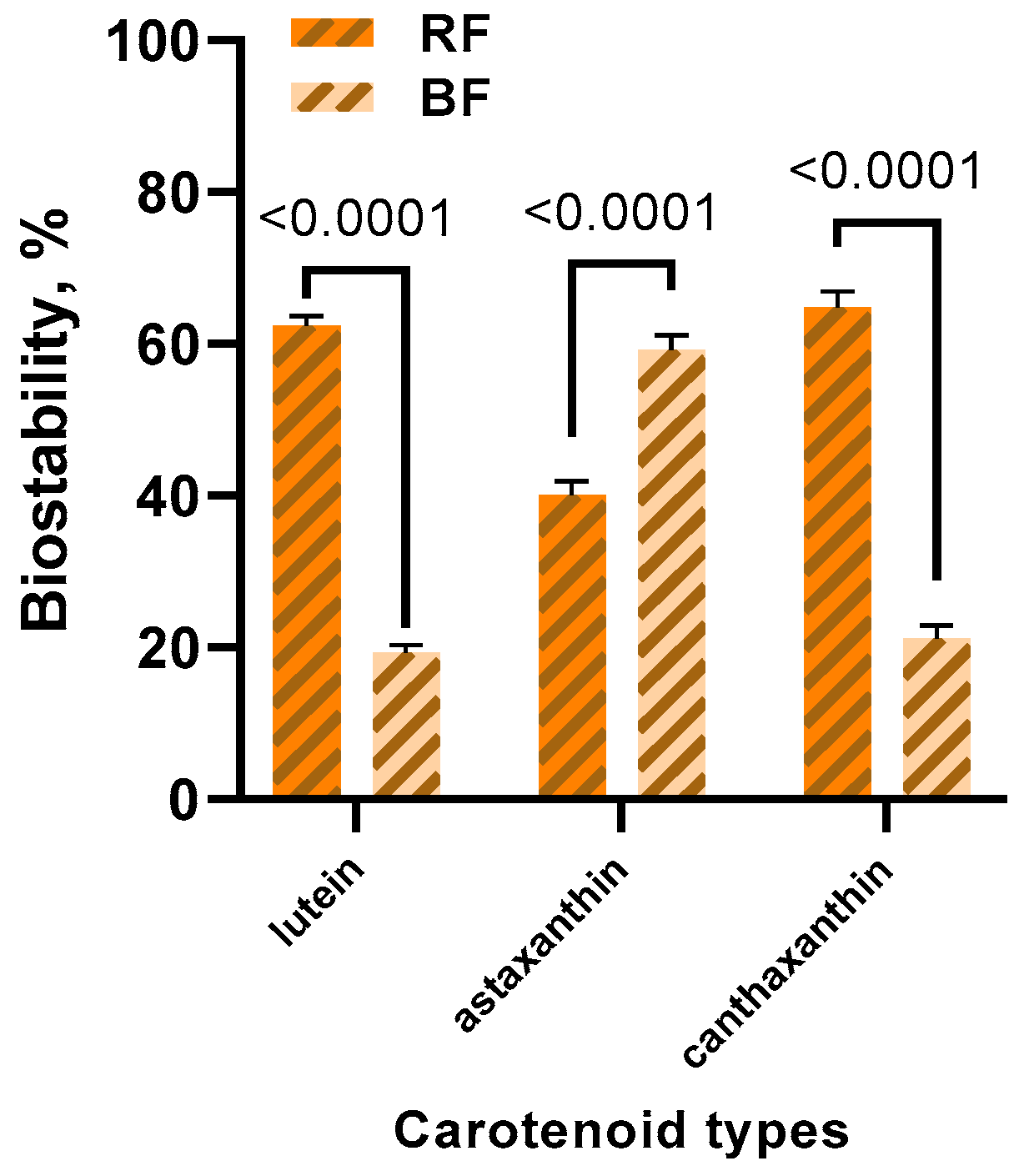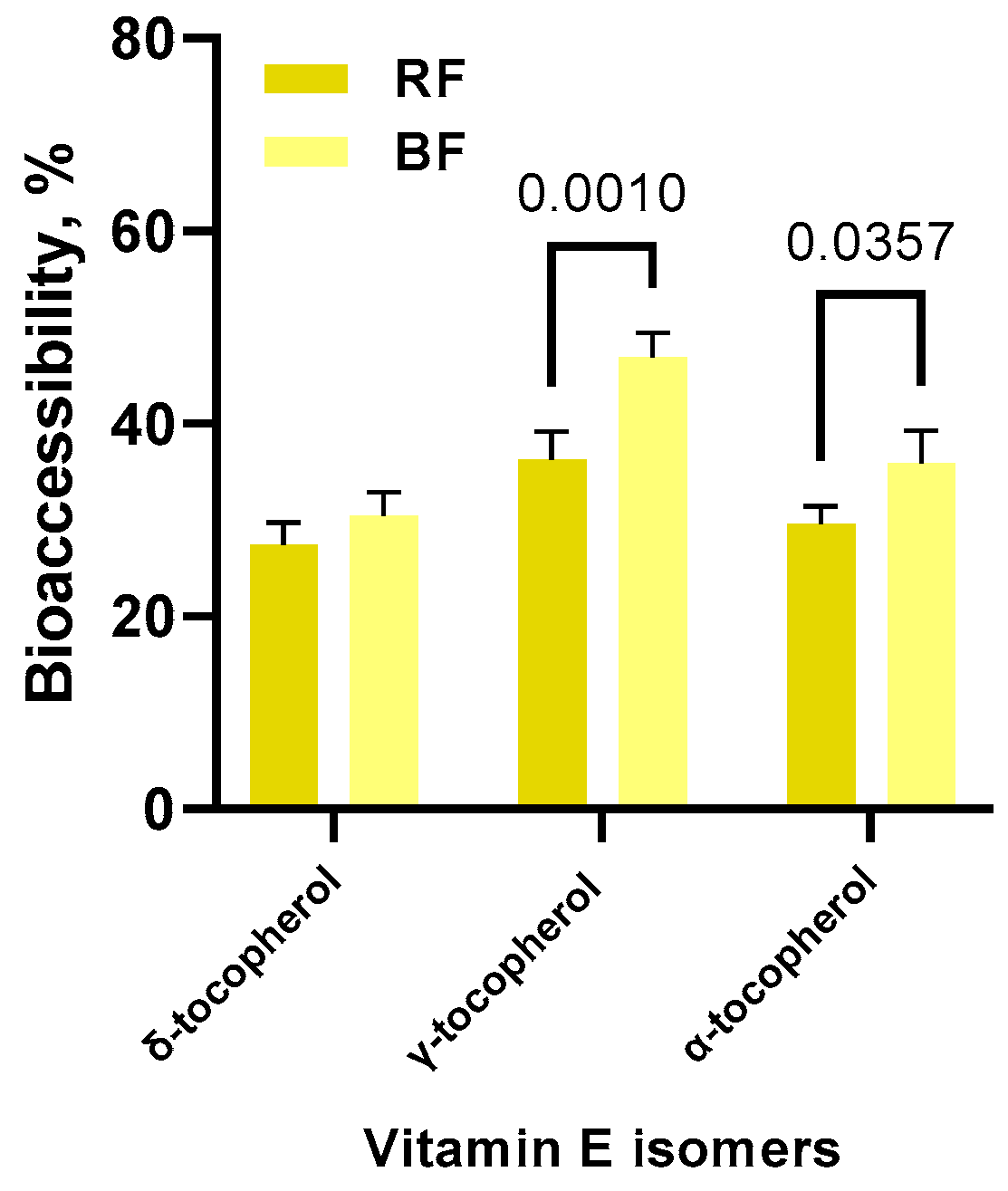Bioactives in Berry Fruits with Emphasis on In Vitro Bioaccessibility for Human Nutrition
Abstract
:1. Introduction
2. Materials and Methods
2.1. Chemicals and Reagents
2.2. Plant Material
2.3. Polyphenols Analysis
2.4. Carotenoids Analysis
2.5. Vitamin E Isomers Analysis
2.6. Simulated In Vitro Gastrointestinal Digestion
2.7. Statistical Analysis
3. Results
3.1. Bioaccessibility of Polyphenols
3.2. Bioaccessibility of Carotenoids
3.3. Bioaccessibility of Vitamin E Isomers
4. Discussion
4.1. Bioaccessibility of Polyphenols
4.2. Bioaccessibility of Carotenoids
4.3. Bioaccessibility of Vitamin E Isomers
5. Conclusions
Supplementary Materials
Author Contributions
Funding
Data Availability Statement
Conflicts of Interest
References
- Golovinskaia, O.; Wang, C.K. Review of functional and pharmacological activities of berries. Molecules 2021, 26, 3904. [Google Scholar] [CrossRef]
- Dixit, V.; Joseph Kamal, S.W.; Bajrang Chole, P.; Dayal, D.; Chaubey, K.K.; Pal, A.K.; Xavier, J.; Manjunath, B.T.; Bachheti, R.K. Functional foods: Exploring the health benefits of bioactive compounds from plant and animal sources. J. Food Qual. 2023, 2023, 5546753. [Google Scholar] [CrossRef]
- Ulaszewska, M.; Garcia-Aloy, M.; Vázquez-Manjarrez, N.; Soria-Florido, M.T.; Llorach, R.; Mattivi, F.; Manach, C. Food intake biomarkers for berries and grapes. Genes Nutr. 2020, 15, 17. [Google Scholar] [CrossRef] [PubMed]
- Bustos, M.C.; Vignola, M.B.; Paesani, C.; León, A.E. Berry fruits-enriched pasta: Effect of processing and in vitro digestion on phenolics and its antioxidant activity, bioaccessibility and potential bioavailability. Int. J. Food Sci. 2020, 55, 2104–2112. [Google Scholar] [CrossRef]
- Vendrame, S.; Del Bo’, C.; Ciappellano, S.; Riso, P.; Klimis-Zacas, D. Berry fruit consumption and metabolic syndrome. Antioxidants 2016, 5, 34. [Google Scholar] [CrossRef] [PubMed]
- Dima, C.; Assadpour, E.; Dima, S.; Jafari, S.M. Nutraceutical nanodelivery; an insight into the bioaccessibility/bioavailability of different bioactive compounds loaded within nanocarriers. Crit. Rev. Food Sci. Nutr. 2021, 61, 3031–3065. [Google Scholar] [CrossRef]
- Roasa, J.; De Villa, R.; Mine, Y.; Tsao, R. Phenolics of cereal, pulse and oilseed processing by-products and potential effects of solid-state fermentation on their bioaccessibility, bioavailability and health benefits: A review. Trends Food Sci. Technol. 2021, 116, 954–974. [Google Scholar] [CrossRef]
- Cervantes, L.; Martinez-Ferri, E.; Soria, C.; Ariza, M.T. Bioavailability of phenolic compounds in strawberry, raspberry and blueberry: Insights for breeding programs. Food Biosci. 2020, 37, 100680. [Google Scholar] [CrossRef]
- Núñez-Gómez, V.; González-Barrio, R.; Periago, M.J. Interaction between dietary fibre and bioactive compounds in plant by-products: Impact on bioaccessibility and bioavailability. Antioxidants 2023, 12, 976. [Google Scholar] [CrossRef] [PubMed]
- Untea, A.E.; Varzaru, I.; Saracila, M.; Panaite, T.D.; Oancea, A.G.; Vlaicu, P.A.; Grosu, I.A. Antioxidant properties of cranberry leaves and walnut meal and their effect on nutritional quality and oxidative stability of broiler breast meat. Antioxidants 2023, 12, 1084. [Google Scholar] [CrossRef]
- Varzaru, I.; Untea, A.E.; Panaite, T.; Olteanu, M. Effect of dietary phytochemicals from tomato peels and rosehip meal on the lipid peroxidation of eggs from laying hens. Arch. Anim. Nutr. 2021, 75, 18–30. [Google Scholar] [CrossRef] [PubMed]
- Varzaru, I.; Untea, A.E.; Van, I. Determination of bioactive compounds with benefic potential on health in several medicinal plants. Rom. Biotechnol. Lett. 2015, 20, 10773–10783. [Google Scholar]
- Oancea, A.G.; Dragomir, C.; Untea, A.E.; Saracila, M.; Cismileanu, A.E.; Vlaicu, P.A.; Varzaru, I. The Effects of Flax and Mustard Seed Inclusion in Dairy Goats’ Diet on Milk Nutritional Quality. Agriculture 2024, 14, 1009. [Google Scholar] [CrossRef]
- Untea, A.E.; Oancea, A.G.; Vlaicu, P.A.; Varzaru, I.; Saracila, M. Blackcurrant (Fruits, Pomace, and Leaves) Phenolic Characterization before and after In Vitro Digestion, Free Radical Scavenger Capacity, and Antioxidant Effects on Iron-Mediated Lipid Peroxidation. Foods 2024, 13, 1514. [Google Scholar] [CrossRef] [PubMed]
- Saracila, M.; Untea, A.E.; Oancea, A.G.; Varzaru, I.; Vlaicu, P.A. Comparative Analysis of Black Chokeberry (Aronia melanocarpa L.) Fruit, Leaves, and Pomace for Their Phytochemical Composition, Antioxidant Potential, and Polyphenol Bioaccessibility. Foods 2024, 13, 1856. [Google Scholar] [CrossRef] [PubMed]
- Mencin, M.; Mikulič Petkovšek, M.; Veberič, R.; Terpinc, P. Simulated gastrointestinal digestion of bioprocessed spelt seeds: Bioaccessibility and bioactivity of Phenolics. Antioxidants 2022, 11, 1703. [Google Scholar] [CrossRef] [PubMed]
- Fotirić Akšić, M.; Nešović, M.; Ćirić, I.; Tešić, Ž.; Pezo, L.; Tosti, T.; Gašić, U.; Dojčinović, B.; Lončar, B.; Meland, M. Chemical fruit profiles of different raspberry cultivars grown in specific Norwegian agroclimatic conditions. Horticulturae 2022, 8, 765. [Google Scholar] [CrossRef]
- Erlund, I.; Freese, R.; Marniemi, J.; Hakala, P.; Alfthan, G. Bioavailability of quercetin from berries and the diet. Nutr. Cancer 2006, 54, 13–17. [Google Scholar] [CrossRef]
- Toshima, S.; Hirano, T.; Kunitake, H. Comparison of anthocyanins, polyphenols, and antioxidant capacities among raspberry, blackberry, and Japanese wild Rubus species. Sci. Hortic. 2021, 285, 110204. [Google Scholar] [CrossRef]
- Larrosa, M.; Tomas-Barberan, F.A.; Espin, J.C. The dietary hydrolysable tannin punicalagin releases ellagic acid that induces apoptosis in human colon adenocarcinoma Caco-2 cells by using the mitochondrial pathway. J. Nutr. Biochem. 2006, 17, 611–625. [Google Scholar] [CrossRef]
- Gasperotti, M.; Masuero, D.; Guella, G.; Palmieri, L.; Martinatti, P.; Pojer, E.; Mattivi, F.; Vrhovsek, U. Evolution of ellagitannin content and profile during fruit ripening in Fragaria spp. J. Agric. Food Chem. 2013, 61, 8597–8607. [Google Scholar] [CrossRef]
- Bobinaitė, R.; Viškelis, P.; Venskutonis, P.R. Chemical composition of raspberry (Rubus spp.) cultivars. In Nutritional Composition of Fruit Cultivars, 1st ed.; Simmonds, M., Preedy, V.R., Eds.; Academic Press: Cambridge, MA, USA, 2016; pp. 713–731. [Google Scholar]
- Türkben, C.; Sarıburun, E.; Demir, C.; Uylaşer, V. Effect of freezing and frozen storage on phenolic compounds of raspberry and blackberry cultivars. Food Anal. Methods 2010, 3, 144–153. [Google Scholar] [CrossRef]
- Qi, Z.; Yang, B.; Giampieri, F.; Cianciosi, D.; Alvarez-Suarez, J.M.; Elexpuru-Zabaleta, M.; Quiles, J.L.; Forbes-Hernandez, T.Y.; Zhang, D.; Bai, W.; et al. The preventive and inhibitory effects of red raspberries on cancer. J. Berry Res. 2024, 14, 61–71. [Google Scholar] [CrossRef]
- Quatrin, A.; Rampelotto, C.; Pauletto, R.; Maurer, L.H.; Nichelle, S.M.; Klein, B.; Rodrigues, R.F.; Junior, M.R.M.; de Souza Fonseca, B.; de Menezes, C.R.; et al. Bioaccessibility and catabolism of phenolic compounds from jaboticaba (Myrciaria trunciflora) fruit peel during in vitro gastrointestinal digestion and colonic fermentation. J. Funct. Foods 2020, 65, 103714. [Google Scholar] [CrossRef]
- Sánchez-Velázquez, O.A.; Mulero, M.; Cuevas-Rodríguez, E.O.; Mondor, M.; Arcand, Y.; Hernández-Álvarez, A.J. In vitro gastrointestinal digestion impact on stability, bioaccessibility and antioxidant activity of polyphenols from wild and commercial blackberries (Rubus spp.). Food Funct. 2021, 12, 7358–7378. [Google Scholar] [CrossRef]
- Mattioli, R.; Francioso, A.; Mosca, L.; Silva, P. Anthocyanins: A comprehensive review of their chemical properties and health effects on cardiovascular and neurodegenerative diseases. Molecules 2020, 25, 3809. [Google Scholar] [CrossRef]
- Gapski, A.; Gomes, T.M.; Bredun, M.A.; Ferreira-Lima, N.E.; Ludka, F.K.; Bordignon-Luiz, M.T.; Burin, V.M. Digestion behavior and antidepressant-like effect promoted by acute administration of blueberry extract on mice. Food Res. Int. 2019, 125, 108618. [Google Scholar] [CrossRef] [PubMed]
- Hackman, R.M.; Polagruto, J.A.; Zhu, Q.Y.; Sun, B.; Fujii, H.; Keen, C.L. Flavanols: Digestion, absorption and bioactivity. Phytochem. Rev. 2008, 7, 195–208. [Google Scholar] [CrossRef]
- Varzaru, I.; Oancea, A.G.; Vlaicu, P.A.; Saracila, M.; Untea, A.E. Exploring the antioxidant potential of blackberry and raspberry leaves: Phytochemical analysis, scavenging activity, and in vitro polyphenol bioaccessibility. Antioxidants 2023, 12, 2125. [Google Scholar] [CrossRef] [PubMed]
- Dewanjee, S.; Bhattacharjee, N.; Chakraborty, P.; Bhattacharjee, S. Carotenoids as antioxidants. In Carotenoids: Structure and Function in the Human Body; Springer: Berlin/Heidelberg, Germany, 2021; pp. 447–473. [Google Scholar]
- Kopec, R.E.; Failla, M.L. Recent advances in the bioaccessibility and bioavailability of carotenoids and effects of other dietary lipophiles. Food Compos. Anal. 2018, 68, 16–30. [Google Scholar] [CrossRef]
- Xavier, A.A.O.; Mercadante, A.Z. The bioaccessibility of carotenoids impacts the design of functional foods. Curr. Opin. Food Sci. 2019, 26, 1–8. [Google Scholar] [CrossRef]
- Failla, M.L.; Huo, T.; Thakkar, S.K. In vitro screening of relative bioaccessibility of carotenoids from foods. Asia Pac. J. Clin. Nutr. 2008, 17 (Suppl. S1), 200–203. [Google Scholar]
- Bohn, T. Metabolic fate of bioaccessible and non-bioaccessible carotenoids. In Non-Extractable Polyphenols and Carotenoids: Importance in Human Nutrition and Health; Saura-Calixto, F., Perez-Jimenez, J., Eds.; The Royal Society of Chemistry: London, UK, 2018; pp. 165–200. [Google Scholar]
- Chacón-Ordóñez, T.; Carle, R.; Schweiggert, R. Bioaccessibility of carotenoids from plant and animal foods. J. Sci. Food Agric. 2019, 99, 3220–3239. [Google Scholar] [CrossRef]
- Reboul, E.; Richelle, M.; Perrot, E.; Desmoulins-Malezet, C.; Pirisi, V.; Borel, P. Bioaccessibility of carotenoids and vitamin E from their main dietary sources. J. Agric. Food Chem. 2006, 54, 8749–8755. [Google Scholar] [CrossRef] [PubMed]
- Hedren, E.; Diaz, V.; Svanberg, U. Estimation of carotenoid accessibility from carrots determined by an in vitro digestion method. Eur. J. Clin. Nutr. 2002, 56, 425–430. [Google Scholar] [CrossRef]
- Hernández-Alvarez, E.; Blanco-Navarro, I.; Pérez-Sacristán, B.; Sánchez-Siles, L.M.; Granado-Lorencio, F. In vitro digestion-assisted development of a β-cryptoxanthin-rich functional beverage; in vivo validation using systemic response and faecal content. Food Chem. 2016, 208, 18–25. [Google Scholar] [CrossRef]
- Carvalho, E.; Fraser, P.D.; Martens, S. Carotenoids and tocopherols in yellow and red raspberries. Food Chem. 2013, 139, 744–752. [Google Scholar] [CrossRef]
- Hunter, S.C.; Cahoon, E.B. Enhancing vitamin E in oilseeds: Unraveling tocopherol and tocotrienol biosynthesis. Lipids 2007, 42, 97–108. [Google Scholar] [CrossRef]
- Varzaru, I.; Untea, A.E.; Saracila, M. In vitro antioxidant properties of berry leaves and their inhibitory effect on lipid peroxidation of thigh meat from broiler chickens. Eur. J. Lipid Sci. Technol. 2020, 122, 1900384. [Google Scholar] [CrossRef]
- Borel, P. Factors affecting intestinal absorption of highly lipophilic food microconstituents (fat-soluble vitamins, carotenoids and phytosterols). Clin. Chem. Lab. Med. 2003, 41, 979–994. [Google Scholar] [CrossRef] [PubMed]






| Specification | Blackberry Fruits | ||||||
|---|---|---|---|---|---|---|---|
| BD | OP | BI (%) | GP | BI (%) | IP | BI (%) | |
| Phenolic acids | |||||||
| Hydroxybenzoic acids | |||||||
| Gallic acid | 0.194 | 0.037 | 18.85 | 0.077 | 39.57 | 0.298 | 153.78 |
| Vanillic acid | 0.025 | 0.006 | 22.67 | 0.009 | 35.82 | 0.025 | 98.70 |
| Syringic acid | 0.012 | 0.003 | 27.14 | 0.005 | 44.10 | 0.006 | 49.14 |
| 3-Hydroxybenzoic acid | 0.019 | 0.011 | 57.80 | 0.017 | 92.88 | 0.030 | 158.33 |
| Ellagic acid | 0.007 | 0.002 | 31.22 | 0.007 | 96.19 | 0.008 | 111.49 |
| Protocatechuic acid | 0.008 | 0.003 | 32.10 | 0.004 | 49.26 | 0.013 | 161.78 |
| Hydroxycinnamic acids | |||||||
| Chlorogenic acid | 0.391 | 0.084 | 21.56 | 0.232 | 59.22 | 0.408 | 104.27 |
| Caffeic acid | 0.011 | 0.002 | 21.89 | 0.005 | 49.29 | 0.009 | 84.87 |
| Methoxycinnamic acid | 0.023 | 0.006 | 25.57 | 0.015 | 67.32 | 0.021 | 91.29 |
| Ferulic acid | 0.033 | 0.013 | 40.34 | 0.014 | 42.63 | 0.006 | 19.43 |
| Coumaric acid | 0.007 | 0.002 | 21.71 | 0.003 | 37.38 | 0.004 | 61.10 |
| Cinnamic acid | 0.027 | 0.003 | 9.23 | 0.000 | 0.00 | 0.027 | 99.36 |
| Flavonoids | |||||||
| Flavanols | |||||||
| Epigallocatechin | 0.000 | 0.000 | 0.000 | 0.000 | 0.000 | 0.000 | 0.000 |
| Catechin | 0.316 | 0.069 | 21.84 | 0.168 | 53.07 | 0.195 | 61.85 |
| Epicatechin | 0.011 | 0.002 | 19.56 | 0.009 | 88.15 | 0.013 | 121.69 |
| Flavonols | |||||||
| Rutin | 0.012 | 0.002 | 15.87 | 0.007 | 63.74 | 0.017 | 142.91 |
| Quercetin | 0.007 | 0.002 | 27.88 | 0.003 | 45.27 | 0.010 | 139.34 |
| Stilbenes | |||||||
| Resveratrol | 0.002 | 0.000 | 11.57 | 0.001 | 40.75 | 0.002 | 99.05 |
| Specification | Raspberry Fruits | ||||||
|---|---|---|---|---|---|---|---|
| BD | OP | BI (%) | GP | BI (%) | IP | BI (%) | |
| Phenolic acids | |||||||
| Hydroxybenzoic acids | |||||||
| Gallic acid | 0.368 | 0.021 | 5.68 | 0.085 | 23.03 | 0.449 | 122.13 |
| Vanillic acid | 0.019 | 0.004 | 22.76 | 0.006 | 33.35 | 0.012 | 60.80 |
| Syringic acid | 0.064 | 0.003 | 4.68 | 0.016 | 25.70 | 0.040 | 62.35 |
| 3-Hydroxybenzoic acid | 0.125 | 0.014 | 11.15 | 0.061 | 49.04 | 0.055 | 43.68 |
| Ellagic acid | 0.122 | 0.003 | 2.32 | 0.018 | 14.58 | 0.076 | 62.76 |
| Protocatechuic acid | 0.198 | 0.009 | 4.79 | 0.020 | 10.14 | 0.080 | 40.42 |
| Hydroxycinnamic acids | |||||||
| Chlorogenic acid | 0.455 | 0.006 | 1.28 | 0.054 | 11.78 | 0.081 | 17.90 |
| Caffeic acid | 0.030 | 0.003 | 8.99 | 0.010 | 32.53 | 0.011 | 37.61 |
| Methoxycinnamic acid | 0.012 | 0.001 | 10.61 | 0.005 | 43.67 | 0.011 | 93.99 |
| Ferulic acid | 0.027 | 0.004 | 13.12 | 0.007 | 26.42 | 0.043 | 160.59 |
| Coumaric acid | 0.037 | 0.001 | 2.39 | 0.001 | 3.73 | 0.021 | 55.02 |
| Cinnamic acid | 0.015 | 0.001 | 4.03 | 0.001 | 8.28 | 0.005 | 30.26 |
| Flavonoids | |||||||
| Flavanols | |||||||
| Epigallocatechin | 1.179 | 0.052 | 4.38 | 0.112 | 9.49 | 0.298 | 25.29 |
| Catechin | 0.501 | 0.019 | 3.85 | 0.075 | 14.99 | 0.068 | 13.60 |
| Epicatechin | 0.300 | 0.007 | 2.40 | 0.026 | 8.66 | 0.109 | 36.33 |
| Flavonols | |||||||
| Rutin | 0.070 | 0.003 | 4.13 | 0.006 | 9.18 | 0.020 | 28.29 |
| Quercetin | 0.049 | 0.001 | 1.78 | 0.002 | 3.65 | 0.006 | 11.48 |
| Stilbenes | |||||||
| Resveratrol | 0.031 | 0.001 | 2.52 | 0.002 | 7.16 | 0.014 | 45.13 |
| Specification | Raspberry Fruits | Blackberry Fruits | ||||
|---|---|---|---|---|---|---|
| BD | IP | IR | BD | IP | IR | |
| Lutein | 46.09 | 7.612 | 28.77 | 110.4 | 18.76 | 21.44 |
| Astaxanthin | 27.93 | 2.061 | 11.20 | 10.87 | 0.642 | 6.433 |
| Canthaxanthin | 1.47 | 0.138 | 0.953 | 5.76 | 0.479 | 1.222 |
| Specification | Raspberry Fruits | Blackberry Fruits | ||||
|---|---|---|---|---|---|---|
| BD | IP | IR | BD | IP | IR | |
| δ-tocopherol | 56.60 | 15.54 | 30.91 | 145.1 | 44.20 | 97.73 |
| γ-tocopherol | 139.3 | 50.52 | 79.91 | 299.6 | 140.4 | 135.4 |
| α-tocopherol | 229.7 | 67.97 | 158.0 | 253.4 | 90.95 | 145.8 |
Disclaimer/Publisher’s Note: The statements, opinions and data contained in all publications are solely those of the individual author(s) and contributor(s) and not of MDPI and/or the editor(s). MDPI and/or the editor(s) disclaim responsibility for any injury to people or property resulting from any ideas, methods, instructions or products referred to in the content. |
© 2024 by the authors. Licensee MDPI, Basel, Switzerland. This article is an open access article distributed under the terms and conditions of the Creative Commons Attribution (CC BY) license (https://creativecommons.org/licenses/by/4.0/).
Share and Cite
Varzaru, I.; Untea, A.E.; Oancea, A.G.; Saracila, M.; Vlaicu, P.A. Bioactives in Berry Fruits with Emphasis on In Vitro Bioaccessibility for Human Nutrition. Separations 2024, 11, 286. https://doi.org/10.3390/separations11100286
Varzaru I, Untea AE, Oancea AG, Saracila M, Vlaicu PA. Bioactives in Berry Fruits with Emphasis on In Vitro Bioaccessibility for Human Nutrition. Separations. 2024; 11(10):286. https://doi.org/10.3390/separations11100286
Chicago/Turabian StyleVarzaru, Iulia, Arabela Elena Untea, Alexandra Gabriela Oancea, Mihaela Saracila, and Petru Alexandru Vlaicu. 2024. "Bioactives in Berry Fruits with Emphasis on In Vitro Bioaccessibility for Human Nutrition" Separations 11, no. 10: 286. https://doi.org/10.3390/separations11100286
APA StyleVarzaru, I., Untea, A. E., Oancea, A. G., Saracila, M., & Vlaicu, P. A. (2024). Bioactives in Berry Fruits with Emphasis on In Vitro Bioaccessibility for Human Nutrition. Separations, 11(10), 286. https://doi.org/10.3390/separations11100286










